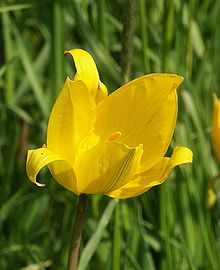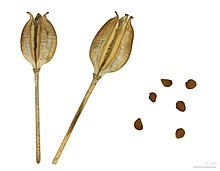Wild tulip
| Wild tulip | ||||||||||||
|---|---|---|---|---|---|---|---|---|---|---|---|---|

Wild tulip ( Tulipa sylvestris ), illustration |
||||||||||||
| Systematics | ||||||||||||
|
||||||||||||
| Scientific name | ||||||||||||
| Tulipa sylvestris | ||||||||||||
| L. |
The Tulipa sylvestris ( Tulipa sylvestris ), also vineyard Tulip , rare forest tulip called, is a plant that the family of the lily family belongs (Liliaceae). She was voted Flower of the Year 1983 .
description
general characteristics
The wild tulip is a perennial herbaceous plant that usually reaches heights of 30 to 45 (10 to 60) centimeters. This geophyte forms onions as a persistence organ. Often the bulbs develop underground stolons , which ensure vegetative reproduction.
leaves
Usually three leaves are formed per plant, in rare cases there can be four of them. The simple, blue-green colored leaves are sessile. The shape of the blade varies from narrow-lanceolate to linear and ends in a pointed, groove-like curved leaf tip. The leaf margin is smooth. The leaves are relatively soft to the touch, hairless and smooth in structure. They develop a length of about 15 to 35 cm and a width between 1 and 2 cm.
Flower and fruit
A terminal, slightly fragrant, bell-shaped flower usually develops per plant . Two flowers can rarely be observed on one plant. The six bracts are arranged in two circles with three bracts each. The bracts of the outer circle are 30 to 40 (to 65) mm long and 8 to 15 (to 25) mm wide, those of the inner circle are 30 to 40 (to 60) mm long and 15 to 20 (to 25) mm wide . The six bracts, which taper towards the front and are hairy at the base, are bright yellow on the inside, the outside sometimes has a greenish or reddish tint. The six fertile stamens also stand together in two equal circles. They are characterized by flat, 8 to 14 mm long, hairy stamens with striking orange anthers . The length of the anthers varies between 4 and 9 millimeters. The wild tulip has a light green, about 10-12 millimeters long, upper ovary, which consists of three intergrown carpels . Partitions divide it into three ovary compartments. Each fruit compartment contains two seed bars. Since there is no stylus , three short, yellow scar lobes close the ovary . The flower closes in the evening and in cloudy, damp weather; in the sun, the bracts spread out to form a large yellow star with a diameter of 7 to 8 cm. The flowering period extends from April to May.
The flat seeds ripen in a leathery, three-chamber capsule fruit
Chromosome number
The number of chromosomes is 2n = 48, less often 24 or 36.
ecology
The wild tulip is the signature species of the Garlic Society, Geranio-Allietum. In north-western Europe it is also found in companies of the Alliarion association.
The flowers are homogamous, fragrant "nectar-bearing disc flowers" with a perigone that spreads in the sunlight . The nectar secretion takes place at the outer stamen base. The papillary scars secrete a sugary fluid that is occasionally ingested by insects . Insects also do pollination . The flowering period extends from April to May. In bushes or forests , the plants usually remain flowerless ( sterile ), but often cover larger areas with their leaves.
The fruit capsules are desiccant spreaders, ie they close when damp. The wind spreads the seeds as a glider pilot. Fruit ripens in July.
Vegetative reproduction occurs through runners and bulbs . It is spread by humans with soil and occasionally as an ornamental plant .
distribution

The origin lies in southern Europe ( Sicily , Greece ), North Africa (Algeria, Libya; Morocco, Tunisia) and Turkey . It is said again and again that the plant was introduced to Central and Western Europe by the Romans, but there does not seem to be any evidence of this. Possibly the vineyard tulip was grown as an ornamental plant in Moorish Andalusia under the name “Macedonian onion” ( basal al-maqdunis ) or “bucket narcissus ” ( naryis qadusi ). It was believed that she came from Alexandria . However, the identification is not completely certain. The vineyard tulip was introduced to Central Europe from Bologna as an ornamental plant in the second half of the 16th century . In the course of time it grew wild, so this species, which is generally rare, is most likely to be found on the edge of old garden cultures or in vineyards as a stinzen plant . On the grounds of Brake Castle in Lemgo there is one of only three known occurrences in North Rhine-Westphalia, it is probably due to overgrown ornamental plants in a baroque garden. Other preferred locations are: Forests, bushes, hedges and vineyards with fat, moist, low-stone loess loam soils with a warm climate. It can be found almost all over Europe.
Tulipa sylvestris is the only wild tulip species in Germany. Usually it only blooms here in sunny locations. The largest collection of wild tulips north of the Alps is found in the vineyards of Gau-Odernheim .
Systematics
With a broad understanding of the species and including several subspecies, the following terms are used synonymously:
- Tulipa australis Link [≡ Tulipa sylvestris subsp. australis ]
- Tulipa biebersteiniana Schult. & Schult. f. [= Tulipa sylvestris subsp. australis ]
- Tulipa primulina Baker [≡ Tulipa sylvestris subsp. primulina ]
Usually three subspecies of the wild tulip ( Tulipa sylvestris ) are accepted:
- Tulipa sylvestris subsp. sylvestris
- Tulipa sylvestris subsp. australis (Link) Pamp.
- Tulipa sylvestris subsp. primulina (Baker) Maire & Weiller
Hazard / protection
The wild tulip is particularly protected in Germany under the Federal Species Protection Ordinance and is considered to be endangered according to the Red List. It must not be dug up or plucked. The intensification of agriculture in the fields of arable and viticulture is seen as the primary cause of the decline in stocks.
The Wild Tulip was voted Flower of the Year in 1983 by the Hamburg Nature Conservation Foundation and the Foundation for the Protection of Endangered Plants .
literature
- Alfred Blaufuss: Waldtulpe, Zierliches Johanniskraut, Waldanemone, three rare plants from the center of Rheinhessen, Heimat-Jahrbuch Alzey – Worms 1973, pp. 323–330.
- O. Sebald, S. Seybold, G. Philippi (Ed.): The fern and flowering plants of Baden-Württemberg, Vol. 7 . E. Ulmer, Stuttgart, 1998. ISBN 3-8001-3316-4
- Brigitte Horak: Vineyard gauntlets in Castell. Castell, April 2007 (leaflet)
- Ruprecht Düll , Herfried Kutzelnigg : Pocket dictionary of plants in Germany and neighboring countries. The most common Central European species in portrait. 7th, corrected and enlarged edition. Quelle & Meyer, Wiebelsheim 2011, ISBN 978-3-494-01424-1 .
- Newspaper article by Joachim Schmitz: The wild tulip - naturalized for centuries ; in Jülicher Zeitung No. 80 of April 4, 2019; P. 12
Individual evidence
- ^ Tropicos. [1]
- ^ Erich Oberdorfer : Plant-sociological excursion flora for Germany and neighboring areas . With the collaboration of Angelika Schwabe and Theo Müller. 8th, heavily revised and expanded edition. Eugen Ulmer, Stuttgart (Hohenheim) 2001, ISBN 3-8001-3131-5 , pp. 132 .
- ↑ Archived copy ( memento of the original from September 24, 2015 in the Internet Archive ) Info: The archive link was inserted automatically and has not yet been checked. Please check the original and archive link according to the instructions and then remove this notice.
- ↑ Distribution map Turkey s. İsmail Eker / M. Tekin Babaç 2010, Tulipa koyuncui Eker & Babaç sp. nov. (Liliaceae) from east Anatolia, Turkey. Nordic Journal of Botany 28, 2010, fig. 3, doi: 10.1111 / j.1756-1051.2009.00591.x
- ↑ J. Esteban Hernández Bermejo, Expiración García Sánchez 2009, Tulips: An Ornamental Crop in the Andalusian Middle Ages. Economic Botany 63/1, 60-66
- ↑ Federal Agency for Nature Conservation (Ed.): Red List of Endangered Animals, Plants and Fungi in Germany - Volume 7: Plants Agricultural Publishing House Münster 2018, ISBN 978-3-7843-5612-9 , p. 22.
- ↑ Rare vineyard tulips blooming at Brake Castle , website of the Landesverband Lippe, April 27, 2018
- ↑ Portrait of the wild tulip
- ↑ Archived copy ( memento of the original from September 24, 2015 in the Internet Archive ) Info: The archive link was inserted automatically and has not yet been checked. Please check the original and archive link according to the instructions and then remove this notice.
- ↑ Archived copy ( memento of the original from September 24, 2015 in the Internet Archive ) Info: The archive link was inserted automatically and has not yet been checked. Please check the original and archive link according to the instructions and then remove this notice.
- ↑ Flower of the year 1983 ( Memento from April 12, 2014 in the Internet Archive )
Web links
- Wild tulip. In: FloraWeb.de.
- Wild tulip . In: BiolFlor, the database of biological-ecological characteristics of the flora of Germany.
- Profile and distribution map for Bavaria . In: Botanical Information Hub of Bavaria .
- Tulipa sylvestris L. s. l. In: Info Flora , the national data and information center for Swiss flora .
- Thomas Meyer: Data sheet with identification key and photos at Flora-de: Flora von Deutschland (old name of the website: Flowers in Swabia )
- Description in the Flora of North America. (English)
- Tulipa sylvestris in Les belles fleurs de la France. (French)




